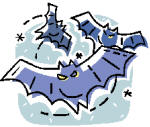 |
|||||||||||||||
|
|
|
|
|||||||||||||
|
ROMANIA
by Beverley Richardson
Romania is surrounded by Slavic countries, so it isn't surprising that their vampires are variants of the Slavic vampire. They are called Strigoi based on the Roman term strix for screech owl which also came to mean demon or witch.
There are different types of strigoi: strigoi vii are live witches who will become vampires after death. They can send out their soul at night to meet with other witches or with strigoi mort who are dead vampires. The strigoi mort are the reanimated bodies which return to suck the blood of family, livestock, and neighbours.
A person born with a caul, tail, born out of wedlock, or one who died an unnatural death, or died before baptism, was doomed to become a vampire. As was the seventh child of the same sex in a family, the child of a pregnant woman who didn't eat salt or was looked at by a vampire, or a witch. And naturally, being bitten by vampire, meant certain condemnation to a vampiric existence after death.
The vircolac which is sometimes mentioned in folklore was more closely related to a mythological wolf that could devour the sun and moon and later became connected with werewolves rather than vampires. The person afflicted with lycanthropy could turn into a dog, pig, or wolf.
The vampire was usually first noticed when it attacked family and livestock, or threw things around in the house. Vampires, along with witches, were believed to be most active on the Eve of St George's Day (April 22 Julian, May 4 Gregorian calendar), the night when all forms of evil were supposed to be abroad. St George's Day is still celebrated in Europe.
A vampire in the grave could be told by holes in the earth, an undecomposed corpse with a red face, or having one foot in the corner of the coffin. Living vampires were found by distributing garlic in church and seeing who didn't eat it.
Graves were often opened three years after death of a child, five years after the death of a young person, or seven years after the death of an adult to check for vampirism.
Measures to prevent a person becoming a vampire included, removing the caul from a newborn and destroying it before the baby could eat any of it, careful preparation of dead bodies, including preventing animals from passing over the corpse, placing a thorny branch of wild rose in the grave, and placing garlic on windows and rubbing it on cattle, especially on St George's & St Andrew's days.
To destroy a vampire, a stake was driven through the body followed by decapitation and placing garlic in the mouth. By the 19th century, people were shooting a bullet through the coffin. For resistant cases, the body was dismembered and the pieces burned, mixed with water, and given to family members as a cure.
SLAVIC VAMPIRES
GYPSIES AND VAMPIRES
EIGHTEENTH CENTURY VAMPIRE CONTROVERSY
|
|||||||||||||||
|
|||||||||||||||

